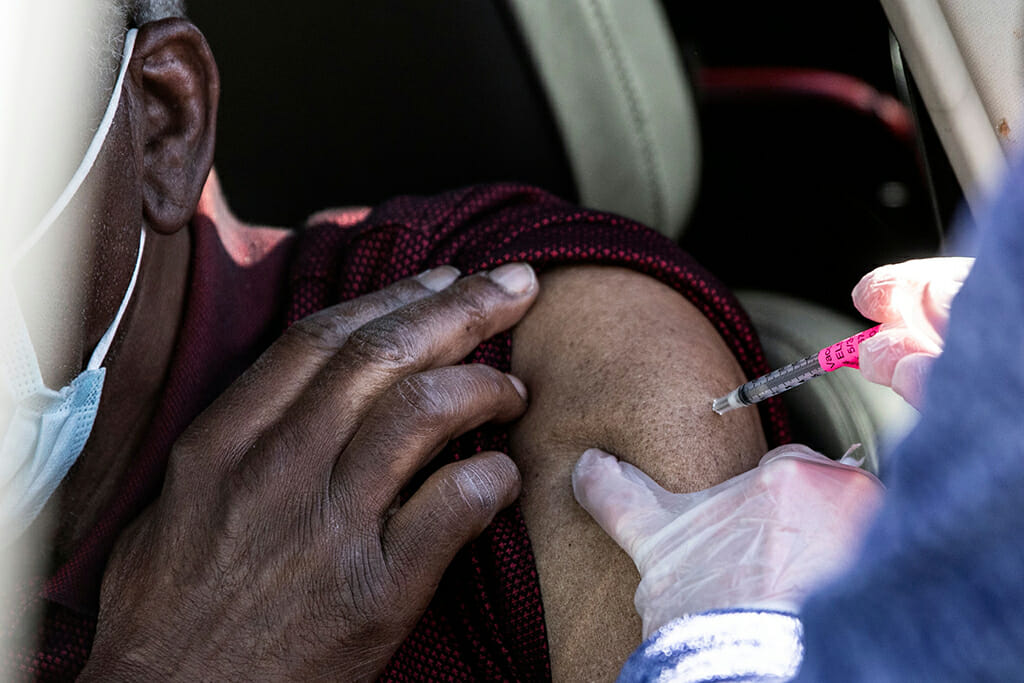The first month of the U.S. vaccination program for COVID-19 proved a rocky one, with inoculation efforts lagging behind schedule and not reaching as many people as initially planned. Now new data released by the Centers for Disease Control and Prevention for the month between December 14, 2020 and January 14, 2021 show major disparities in the racial and socioeconomic status of individuals receiving the vaccine.
The preliminary data show that Black and Hispanic people have been vaccinated at lower rates than white people. A similar disparity has been reflected in COVID-19 infection rates and deaths throughout the pandemic.
Danielle Ompad, associate professor of epidemiology at the NYU School of Global Public Health, said the vaccination data is troubling. “It’s a new intervention, and there are already disparities in who’s getting the intervention and who’s not getting the intervention – that’s problematic at the get-go,” she explained.
More than 60% of people vaccinated during that first month were white, while 11.5% were Hispanic and 5% Black. For context, Black people make up more than 13% of the U.S. population and Latinos 17%.
The CDC data is limited, given that they were compiled early in the vaccination rollout and that most states aren’t reporting vaccination data by ethnicity or demographic. As of January 19, only 17 states were reporting this information.
But according to a Kaiser Family Foundation analysis, these initial vaccination patterns raise a real red flag. In Mississippi, for example, Black people represent 38% of COVID-19 cases and 42% of deaths – but they’ve only received 15% of vaccinations.
Ompad believes the vaccination disparities can be traced to two main factors: lack of access and vaccine hesitancy. These are both issues steeped in decades of structural racism that the Biden administration’s health policy team will have to tackle.
Historically, unethical research like the Tuskegee Study, which was conducted in Black men over the course of 40 years without their consent, has created mistrust in the U.S. healthcare system among Black Americans.
“These negative things are still stuck in the minds of Black people,” Ompad explained. “People have not been treated well by the healthcare system for decades. Their concerns are not listened to and they don’t get treated in the same way.”

In New York, public officials acknowledged this week that the current racial disparity in vaccination rates will need to be addressed with urgency. “We got a lot of work to do, because it’s a combination of, we need a hell of a lot more supply and we need to work on the real concerns about trust and hesitancy,” New York City mayor Bill de Blasio said.
Public officials said the city will hone its grassroots efforts to get vaccines to hard-hit communities. New York governor Andrew Cuomo noted that “you can’t just rely on traditional healthcare means because you are dealing with healthcare deserts – and when you just use the private healthcare system, you are not going to bring vaccines to the desert.”
One major barrier, Ompad pointed out, is that vaccine doses simply are not reaching their intended recipients. Among other places, this occurred in Washington Heights, a largely Latino neighborhood in New York City. Public health officials said the vaccination site located within its borders saw more white New Yorkers arriving from different parts of the city than members of the local Latino community.
Meanwhile, individuals who work unconventional schedules may have a hard time finding vaccination sites able to accommodate them. And then there’s the sign-up process, which may not be as straightforward as it should.
“The sign-up for New York has been utterly confusing,” Ompad explained. “If you are not internet-savvy, it can be a real challenge. And if you don’t have access to the internet or you have poor internet connections, it can be very difficult.”
One way to address these challenges is to make sure vaccination sites target specific communities. The NewYork-Presbyterian site in Washington Heights acknowledged concerns about who was receiving vaccines and announced new guidelines requiring a minimum of 60% of vaccinations to be administered to residents in Washington Heights, Inwood, Northern and Central Harlem and the South Bronx.
“That’s one way to do it,” Ompad said. “To identify those neighborhoods where we have significant disparities, and make sure the vaccination centers in those neighborhoods are serving those communities. And to think about where we’re putting our vaccine centers, to make sure they’re in neighborhoods in which they are highly effective.”
These changes need to be buttressed by informational campaigns that address bigger-picture concerns about vaccines. The safety profile and importance of vaccines should be communicated by spokespeople from affected communities.
At the federal level, Biden has set up a Health Equity Task Force that has yet to come up with any concrete guidelines. The founding of the task force is largely seen as a first step in a long-overdue process to achieve health equity. Its initial focus will be on distributing COVID-19 resources and relief funds equitably and on gathering demographic data. It will also concentrate on more effectively circulating vaccine data to help states better target marginalized communities.
Ultimately, it will be a matter of developing rules to streamline the vaccination process and “create guidance for states and jurisdictions for meeting those rules,” Ompad said. Once such guardrails are in place, “The task force could have an impact. But it shouldn’t just be creating guidelines on what we should be doing. There should also be monitoring whether it happens, and creating consequences for when it doesn’t happen.”







